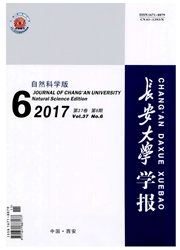

 中文摘要:
中文摘要:
水分迁移是引起路基下土体冻胀的重要因素,目前国内外仍采用刚性孔隙来模拟水分迁移,这对承受荷载的土体并不适用。根据能量平衡与质量守恒原理,结合有效应力与孔隙率、体积含冰量与温度的关系,建立了压力作用下的考虑孔隙率变化的一维水热模型。基于改进的水分迁移试验装置,利用粉质粘土进行了开放系统下的水分迁移试验。研究结果表明:随着冻结时间的增长,补水量逐渐增大,导致冻胀过程经历缓慢变形、快速上升和下降3个阶段,荷载对最大冻胀速率的影响明显;最大含水率位置随着冻结锋面的下移而下移;随着荷载的逐渐增大,水分迁移量逐渐减小,开始补水的时间也推后。
 英文摘要:
英文摘要:
The water migration is of great significance for frost heave. However, the rigid void was used to simulate the water migration process, which may not be available for the soils bearing ground pressure. According to the energy conservation and mass conservation principle, one dimensional water-heat transport theory under pressure which considered the porosity was established. This process was combined with the relationship between effective stress and pore ratio, volume ice content and the temperature. Based on the moisture migration experiment apparatus, a series of moisture migration tests were carried out on silty clay under various pressures in an open system. Results indicate that the amount of water intake increases with the elapsed time, resulting in the three different stages in the process of the frost heave, slow deformation, rapid increasing and decreasing stage, respectively. The frost heave rate is sensitive to the overburden pressure. The position of peak water content moves downward with the descending of freezing front. As the overburden pressure increases, the amount of water migration decreases gradually and the time to start water uptake delays. 1 tab, 10 figs, 16 refs.
 同期刊论文项目
同期刊论文项目
 同项目期刊论文
同项目期刊论文
 期刊信息
期刊信息
